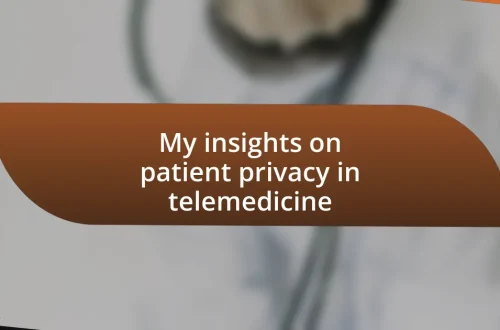
My thoughts on the future of telehealth
Key takeaways:
- The future of telehealth is being shaped by advancements in AI and personalized medicine, enhancing patient outcomes and accessibility.
- Telehealth offers significant benefits, including increased accessibility, reduced travel costs, and improved chronic condition monitoring.
- Challenges include technology resistance, regulatory confusion, and the digital divide, which hinder widespread adoption.
- Effective telehealth integration requires user-friendly technology, staff training in empathetic communication, and ongoing patient feedback for improvement.

Future trends in telehealth
The future of telehealth is poised for a significant shift, especially with the increasing adoption of artificial intelligence (AI) tools. I remember a time when a simple chatbot could only answer basic questions, yet now, AI can help diagnose conditions through symptom checkers. Isn’t it fascinating to think about how these technologies could enhance patient outcomes and make healthcare more accessible?
Personalized medicine is another trend I find compelling. In my experience, tailoring treatments based on individual genetics and lifestyle can lead to better health outcomes. As telehealth integrates genomic data, I wonder if we’ll soon see a world where our virtual consultations involve discussions about our DNA—how exciting and intimate that could be!
Moreover, the emphasis on mental health services through teletherapy is growing. I’ve seen friends benefit immensely from online therapy during stressful times, which underscores how telehealth can break geographical barriers. What if we embraced this trend and prioritized mental well-being as much as physical health? The potential to connect with diverse practitioners could change lives, and I look forward to seeing how this evolves.

Benefits of telehealth advancements
The advancements in telehealth are not just about convenience; they are genuinely transformative. I recall a time when scheduling a doctor’s visit meant taking time off work and commuting long distances. Today, I can consult a doctor from the comfort of my home, saving both time and mental energy. This shift is empowering patients, fostering a proactive approach to their health management.
Here are some key benefits of telehealth advancements:
– Increased accessibility for patients in rural or underserved areas
– Reduced travel time and associated costs
– Enhanced monitoring of chronic conditions through wearable technology
– Greater flexibility in scheduling appointments, making it easier to fit healthcare into busy lives
– Improved patient engagement and continuity of care through follow-up virtual visits

Challenges facing telehealth adoption
Adopting telehealth is not without its hurdles. One major challenge I’ve observed is the resistance from both healthcare providers and patients to embrace new technologies. For instance, I’ve spoken with elderly patients who feel overwhelmed by the idea of using a smartphone or a computer for their doctor’s visits. This discomfort can lead to a reluctance to seek necessary care, highlighting the need for better education and support around technology use.
Another significant obstacle is related to regulatory and reimbursement policies. In my experience, healthcare providers often face confusion about what services are covered and how to navigate billing for telehealth visits. I once encountered a friend who had a virtual consultation for a pressing health issue but was later surprised to receive an unexpected bill because their insurance didn’t fully cover the session. Such unpredictability can discourage both patients and providers from fully engaging with telehealth options.
Lastly, the digital divide remains a pressing concern, particularly for low-income and rural populations. I’ve often wondered how many potential patients miss out on crucial healthcare simply because they lack access to reliable internet or necessary devices. The disparity in technology access not only limits telehealth’s reach but also reinforces existing health inequities.
| Challenge | Description |
|---|---|
| Technology Resistance | Patients and providers may feel uncomfortable using new technologies, creating barriers to engagement. |
| Regulatory Confusion | Unclear policies around reimbursement can lead to unexpected costs, deterring utilization. |
| Digital Divide | Lack of access to reliable internet and devices can limit telehealth availability for underserved populations. |

Role of technology in telehealth
Technology plays a pivotal role in the expanding sphere of telehealth, enabling healthcare providers to reach patients in unprecedented ways. I recall a time when I observed a telemedicine session where the physician utilized a remote monitoring device. This technology allowed them to track the patient’s health metrics in real time, which not only boosted the patient’s confidence but also enhanced the doctor’s ability to make informed decisions. Reflecting on this, can you imagine how these innovations can transform the patient experience?
Moreover, the integration of artificial intelligence is changing how care is delivered. Tools like chatbots can pre-screen patients and answer routine questions, creating a more efficient workflow. I find myself wondering how much more streamlined the healthcare process could become as these technologies evolve.
The advent of high-definition video conferencing has also made a significant impact. I still remember the first time I witnessed a family across the country connecting with a specialist via a virtual visit. The emotional relief of that family was palpable; they no longer had to travel long distances for expert care. This demonstrates just how crucial technology is in bridging gaps and ensuring that quality healthcare is accessible to more people than ever before.

Telehealth policy and regulation changes
As telehealth continues to grow, the need for clear policies and regulations becomes paramount. I recall a discussion I had with a healthcare administrator who expressed their frustration with the lack of uniform regulations across states. It became evident how varying policies can inhibit the ability to deliver consistent patient care. Shouldn’t there be a standardized approach to ensure everyone benefits from these advancements?
Recent regulatory changes have begun to address some of these concerns, particularly during the pandemic when emergency measures allowed for greater flexibility in telehealth services. I remember feeling a wave of relief when I read about the temporary waivers for certain licensing requirements. It made me realize how essential it is for policymakers to prioritize these updates even beyond emergencies, ensuring that patients can receive care from providers, regardless of geographic boundaries.
Looking ahead, the balance between patient privacy and accessibility will be critical in shaping telehealth policies. I’ve often wondered how policymakers can strike that delicate balance. This consideration is crucial, as patients must feel secure sharing sensitive information while still enjoying the convenience that telehealth provides. The ongoing conversations around regulation will ultimately determine the future landscape of this vital healthcare service.

Strategies for effective telehealth integration
One effective strategy for integrating telehealth is to invest in user-friendly technology. I remember when I first tried a telehealth platform; it was both exciting and slightly intimidating. The last thing you want is for patients to feel overwhelmed by complex systems. By prioritizing intuitive interfaces and comprehensive support resources, healthcare providers can greatly enhance patient engagement and satisfaction.
Another critical aspect is training staff not only in technical skills but also in empathetic communication. In my experience, the quality of a virtual consultation often hinges on how connected the healthcare provider can make the patient feel. I find it fascinating to think about how a simple smile or tone of voice can build trust through a screen. Implementing regular training sessions that focus on these soft skills can facilitate a more compassionate approach to care.
Moreover, actively gathering patient feedback is paramount for continuous improvement. I recall how a healthcare facility I worked with transformed its telehealth services after conducting patient surveys. The insights shared were invaluable, revealing both strengths and areas for improvement that we hadn’t even considered. This ongoing dialogue fosters a culture of responsiveness, ensuring that patients feel heard and valued in their care journey. What strategies have you seen work in your community?




